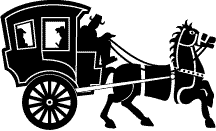
Transportation in the
19th Century
by Michelle J. Hoppe
 |
Transportation in the 19th Century by Michelle J. Hoppe |
|
Carts, drays, vans and wagons were generally used for carrying goods in England. They could also be used to carry people, but generally people of the lower orders. Carriages carried people in England.
Barouches, landaus, victorias, curricles and broughams were all
carriages. They varied in
body shape and number of horses pulling them.
Barouche--a four-wheel fancy carriage with a fold-up hood at the back and with two inside seats facing each other. It was the fancy carriage of the first half of the 19th century. Berlin--A big four-wheel carriage with a hood. Curricle--A two-wheel carriage that was fashionable in the early 1800s. It was pulled by two horses and deemed sporty by the younger set. Gig--A two-wheel vehicle intended for single-horse driving by an owner. Landau--Open, fancy carriage with four wheels with a hood at each end and two seats opposite each other. It was popular in the first half of the 19th century. Two horses pulled the landau. Phaeton--A light four-wheel carriage with open sides and drawn by one or two horses. Victoria--A low, open carriage with four wheels,
which sat only one or two people. It
was in use from about mid-century and very popular with ladies' driving.
Brougham--All-purpose everyday vehicle for the
quality in the latter part of the century.
Originally a two-wheel vehicle, by the latter part of the 19th
century, they were most often four-wheel carriages.
Hackney--For hire, hackneys were often discarded carriages of the wealthy. They served as taxis in the 19th century. Cabriolet--(cab)--These were introduced into England in the 1820s from France. They quickly replaced hackney coaches. Hansom--Invented in the 1830s, it had two wheels and the driver sat in back, so the passengers could get a clear view of where they were going. They eventually replaced the cabs. It was introduced into the United States later in the century. By the 1890s, tires were rubber, making the ride smoother. Omnibus--The first one appeared in London in 1829 and
carried about 22 passengers. By
the 1880s, a circular staircase leading to the roof added more seating on
top. They carried 12
passengers inside and 14 on top. They
ran fixed routes and were pulled by horses.
Waggon--long, heavy vehicle used in the English countryside for carrying heavy goods and people who didn't have the money to travel fast. Dray--a cart with no sides used for hauling heavy loads. Van--A covered-over, lightweight version of the
waggons used for hauling goods, and sometimes for people.
Coaches were enclosed, four-wheel vehicles used for long-distance travel. Stagecoach--coaches which stopped at various pre-appointed stages in order to pick up and drop off passengers. They were the only way to visit people not on the mail coach routes. They were built to carry the same passengers as the mail coaches. Mail coaches--subsidized or owned by the post office
and painted uniformly. They
carried four inside passengers and up to eight outside passengers. Mailbags were piled on the roof and luggage was carried in
receptacles called boots.
Road Wagon, Dog-cart, and Surrey--Were most useful for country work and for fast trotting. Rockaway--Usually relegated to country use, as it was difficult for the coachman to drive in crowded streets on a low seat. They were either closed or open. Runabout--The most generally used light wagon for two passengers. Wagonette--lightweight and led by two horses, it was useful in the country because it carried a large number of passengers with the least effort to the horses. Sources: G. & D. Cook & Co.'s Illustrated Catalogue of Carriages and Special Business Advertiser foreward by Paul H. Downing (Dover Publications) Driving Horse-Drawn Carriages for Pleasure by
Francis T. Underhill (Dover Publications) What Jane Austen Ate and Charles Dickens Knew by Daniel Pool (Simon & Schuster) The Writer's Guide to Everyday Life in Regency and Victorian England by Kristine Hughes (Writer's Digest Books) |
|
|
Top of Page | About Literary Liaisons | Author Links | Bookstore Index | Fiction | Non-Fiction | Feature Title | Video Library | Newsletter | Research Articles | Reference Books | On-line Resources | RWA Chapters | Sign Our Guestbook | Contact Us | Home Copyright 2001, M. Hoppe
|